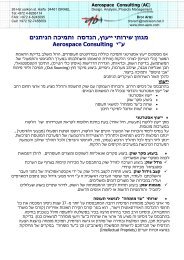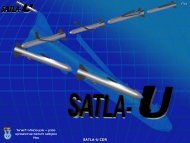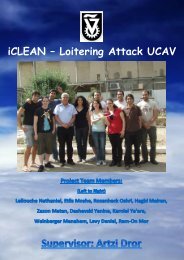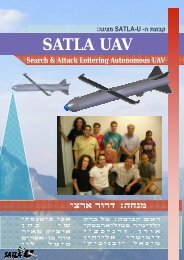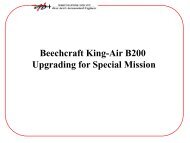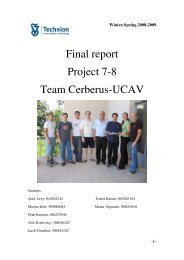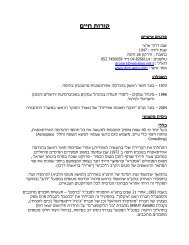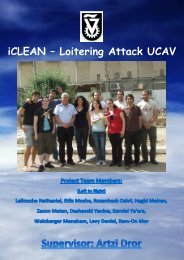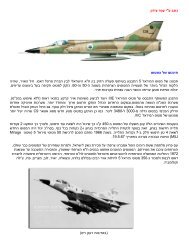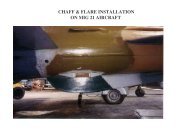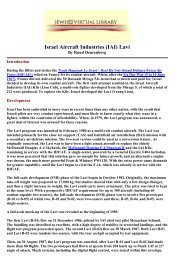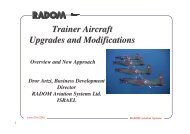wind tunnel paper.pdf - aero.com
wind tunnel paper.pdf - aero.com
wind tunnel paper.pdf - aero.com
You also want an ePaper? Increase the reach of your titles
YUMPU automatically turns print PDFs into web optimized ePapers that Google loves.
LESSONS FROM WIND TUNNEL MODELS<br />
MADE BY RAPID PROTOTYPING<br />
Dror Artzi<br />
Faculty of Aerospace Engineering<br />
Technion – Israel Institute of Technology<br />
Technion City, Haifa 32000, Israel<br />
Ehud Kroll<br />
Faculty of Aerospace Engineering<br />
Technion – Israel Institute of Technology<br />
Technion City, Haifa 32000, Israel<br />
ABSTRACT<br />
Wind <strong>tunnel</strong> model design and construction has traditionally been a relatively long, tedious<br />
and expensive process. Rapid Prototyping (RP) technologies, which have been used for<br />
general geometrical modeling, have recently been applied to <strong>wind</strong> <strong>tunnel</strong> model production.<br />
In spite of our initial doubts as to the adequacy of the RP techniques for this purpose, we<br />
have produced two models of airplanes designed by students as part of their final-year<br />
project. Both models consisted of four main parts: fuselage, nose section and two wings, plus<br />
an assortment of small, interchangeable control surfaces. They had a wing span of 600 mm<br />
and their structure was reinforced with metal inserts to provide added stiffness. The results of<br />
testing the models in a subsonic <strong>wind</strong> <strong>tunnel</strong> indicate that <strong>aero</strong>dynamic data of acceptable<br />
quality can be collected from rapid prototyping models while offering significant cost and<br />
production time advantages over machined metal ones.<br />
INTRODUCTION<br />
The technology of Rapid Prototyping (RP), which has been around for over 20 years, allows<br />
the fabrication of a physical object directly from the CAD model in an additive, layer-bylayer<br />
manner. The prototypes are made of various materials, such as polymers, metals and<br />
<strong>paper</strong>, using different technologies. A promising application of RP is the production of <strong>wind</strong><br />
<strong>tunnel</strong> models for checking, verifying and generating data such as lift and drag coefficients,<br />
pressure distributions, etc. Traditional <strong>wind</strong> <strong>tunnel</strong> models are made of aluminum or steel by<br />
5-axis CNC milling, take weeks or months to fabricate, and cost tens, even hundreds of<br />
thousands of dollars [1]. A number of case studies show that making <strong>wind</strong> <strong>tunnel</strong> models by<br />
RP can produce good results in terms of <strong>aero</strong>dynamic performance and characteristics, while<br />
incurring a five- to tenfold reduction in cost and a significant shortening of acquisition time.<br />
Landrum et al. [2] tested three 30-cm span by 10-cm chord airfoil models in a low-speed<br />
subsonic <strong>wind</strong> <strong>tunnel</strong>: a conventional cast polyurethane model and two photopolymer models<br />
made by stereolithography (SLA). All three models were identical except for the light<br />
sanding of one of them to produce a smoother surface finish. They reported <strong>com</strong>parable<br />
fabrication times and dimensional tolerances for the RP and conventional models, with the<br />
biggest difference being in the drag coefficient for both the RP models, which was about half<br />
the value measured for the cast model. They attributed this result to the rougher surface of the<br />
RP models inhibiting the formation of laminar separation bubbles.<br />
Springer and Cooper [3] <strong>com</strong>pared the static stability <strong>aero</strong>dynamic characteristics obtained in<br />
a trisonic <strong>wind</strong> <strong>tunnel</strong>, over a range of Mach numbers from 0.3 to 5.0, for models made by<br />
three different RP technologies, and one control model made of aluminum. They tested<br />
models made of ABS plastic by fused deposition modeling (FDM), photopolymer resin made<br />
2



